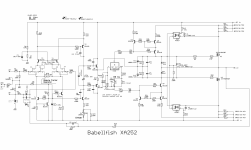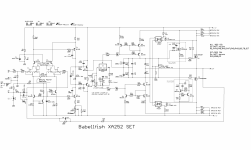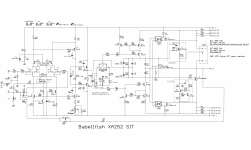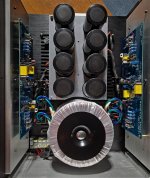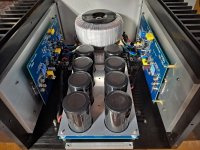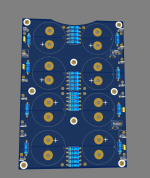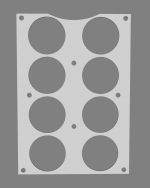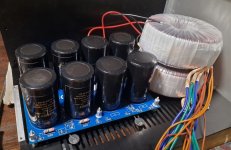No, sadly it is not. However, it is Papa’s and Mightynezzez single most important common denominator and ancestor 🙂Is that you Andy? Nice boots 🙂
Zardoz the great!
It´s me again, Mightiness 🙂
I checked Post 119 against the received new schm, and there are some differences, could you please explain it?
And yes, THE question: should I go for the Schaded version (but no SIT)? Which version would you prefer?
- Post 119 schm has in the SIT/Schaded area a 0R (R45) between R44 ans R46, in the received schm is this 0R missing
- Post 119 R50 is 750R, the same in the new schm is stated as "47R or 750R" (and called R51)
- Old schm R6 10k, new schm R6 15k
Many thanks!
can't say which iteration you should build (first) - as I have all sorts of amps on disposal (when I want to), I really have no preference
now, you having Iron Pumpkin in front, so no Sugar per se, and speakers you have are not hard to drive, maybe going to SIT iteration is best bet - slightly decreased power vs. full MOS, but somewhat more Sugar
so, best of both worlds, sort of
see enclosed
Attachments
I pretty much finished the Babblefish XA252 earlier today. I have a few loose ends to tie up like snubber boards for the rectifiers and wiring in the power switch.
I was up for a new project. I wanted a large amp and I wanted it to be Babblefished... I had thought of building something like a space heater... Ahem, I mean Babblefish XJ but Zen Mod talked me off of the ledge and suggested this sweet XA252.
I used two 500va Antek AN5428 transformers. The price increase for larger toroids was something like $30 over using the 300va and I could use the workout.
The power supply PCBs are something I drew up for 8x52mm screw terminal capacitors in dual mono CRC. I had the caps sitting around and wanted to use them. So the amp has 4x47000uf 40v caps per channel. The PCB has Separate grounds with two spots for CL-60's on the board. Although it is CRC I have room if I want to run CLC by putting the board on taller standoffs. Then there is an aluminum beauty plate that covers everything.
The case is an alie express case. I bought the 3/8" aluminum for the heat spreaders, cut drilled tapped and brushed. The main reason for the heat spreader was that I didn't want to bottom-tap the holes into the heatsinks. I did that once on an ACA mini experiment. Long story short, there is a tap that lives in that amp... So I put through holes in the heatsink and threads in the spreaders so I could fasten them to the amp. All of the holes for the boards etc are through-holed and tapped as well. Easy peasy. Well, easier anyway.
I will post a few pictures up in the next few days of the finished amp with all the wiring in place along with a couple of pics of the circuit board close-up.
Up until now, I have been using a heavily modified Threshold S/500 that has been converted to class A and has Mr. Pass's new stasis front end. I have also built a few first watt clone type amps a variety of preamps etc. I thought The old upgraded Threshold sounded pretty good and that this XA252 would be a marginal upgrade or maybe just different. The XA252 is much better in almost if not all regards. I need to plug the threshold in and listen to them both.
I believe the Threshold has a slightly more forward presentation. Maybe a fuller sound. I will know for sure when I double back and listen to it again. The XA252's bass is very dynamic sounding with much more control than the Threshold. This is crazy because that is what the Thresholds were known for back in the day. All with the two pucks per channel... It is a very fast and detailed amp. I am impressed. Things sound more real. I am impressed. 🙂
I was up for a new project. I wanted a large amp and I wanted it to be Babblefished... I had thought of building something like a space heater... Ahem, I mean Babblefish XJ but Zen Mod talked me off of the ledge and suggested this sweet XA252.
I used two 500va Antek AN5428 transformers. The price increase for larger toroids was something like $30 over using the 300va and I could use the workout.
The power supply PCBs are something I drew up for 8x52mm screw terminal capacitors in dual mono CRC. I had the caps sitting around and wanted to use them. So the amp has 4x47000uf 40v caps per channel. The PCB has Separate grounds with two spots for CL-60's on the board. Although it is CRC I have room if I want to run CLC by putting the board on taller standoffs. Then there is an aluminum beauty plate that covers everything.
The case is an alie express case. I bought the 3/8" aluminum for the heat spreaders, cut drilled tapped and brushed. The main reason for the heat spreader was that I didn't want to bottom-tap the holes into the heatsinks. I did that once on an ACA mini experiment. Long story short, there is a tap that lives in that amp... So I put through holes in the heatsink and threads in the spreaders so I could fasten them to the amp. All of the holes for the boards etc are through-holed and tapped as well. Easy peasy. Well, easier anyway.
I will post a few pictures up in the next few days of the finished amp with all the wiring in place along with a couple of pics of the circuit board close-up.
Up until now, I have been using a heavily modified Threshold S/500 that has been converted to class A and has Mr. Pass's new stasis front end. I have also built a few first watt clone type amps a variety of preamps etc. I thought The old upgraded Threshold sounded pretty good and that this XA252 would be a marginal upgrade or maybe just different. The XA252 is much better in almost if not all regards. I need to plug the threshold in and listen to them both.
I believe the Threshold has a slightly more forward presentation. Maybe a fuller sound. I will know for sure when I double back and listen to it again. The XA252's bass is very dynamic sounding with much more control than the Threshold. This is crazy because that is what the Thresholds were known for back in the day. All with the two pucks per channel... It is a very fast and detailed amp. I am impressed. Things sound more real. I am impressed. 🙂
Attachments
Very rarely and only if you ask it extremely nicely, for example using it to overdrive Maggie 3.6’sI don’t remember seeing someone else asking this, is OS leaving class A?

Square law performance increases class A envelope, and the push pull nature of Mike’s iteration ensures class A/B above safe listening levels, and that again is dependant upon which speakers it is asked to drive, listening habits, room, etc.
Last edited:
maybe it’s the pictures but are the spreaders sufficiently attached to the heat sinks to transfer the heat well? It looks to me like there should be far more screws to ensure a tight fit, plus thermal paste of course.and threads in the spreaders so I could fasten them to the amp.
.......Things sound more real. ......
and then, to tailor it to your ear/brain combo, you have 3 iterations to choose from - full MOS, Schade MOS, SIT ...... and for each of them there is BFR - Beauty Factor Resistor, altering it's value will vary amount of THD and (in specific cases) also Spectra of it
btw. when having pucks as outputs, no need for 2 corner stand-offs; they're needed only when having SIT outboard, on that side, instead of puck
I don’t remember seeing someone else asking this, is OS leaving class A?
with 35Vdc rails and 1A8 Iq, it'll hit voltage clipping level, before leaving A Class
so, you can count on 50W@8R of A Class ....... which is more or less, full power of amp
that - speaking of pure MOS iteration
of course that situation with Schade and SIT arrangements is different
but these are gaining some other virtues, even if decreasing power level compared to pure MOS
virtues - endless pool for bragging in front of friends

It is the pictures. The heat spreader has so much surface area that the transfer of heat is very good. Although the heat spreader is tight, there is no gap and it has a little bit of thermal grease for good measure. I believe it is a shadow you are seeing.maybe it’s the pictures but are the spreaders sufficiently attached to the heat sinks to transfer the heat well? It looks to me like there should be far more screws to ensure a tight fit, plus thermal paste of course.
When I was taking my Threshold apart to modify it, I took the heatsinks off of the heat spreader. There was only one bolt per heatsink and no thermal grease. The thermal transfer on that amp is still great. I added some thermal grease which didn't make a difference. Also, something that confused me was there was a shoulder on the bolts that held the heatsinks on so that they couldn't be out on too tight. Fully tightened, you could move the heatsink on the rail with your hand. Maybe that was meant to address thermal expansion concerns. The heat transfer on that amp was good.
Yes, I read through the whole thread a couple of times and saw all the graphs etc. Very neat. The standoffs that I had were the exact same height as the pucks so I went ahead and put them in. Those pucks are pretty stout. Could probably hold up a car...and then, to tailor it to your ear/brain combo, you have 3 iterations to choose from - full MOS, Schade MOS, SIT ...... and for each of them there is BFR - Beauty Factor Resistor, altering it's value will vary amount of THD and (in specific cases) also Spectra of it
btw. when having pucks as outputs, no need for 2 corner stand-offs; they're needed only when having SIT outboard, on that side, instead of puck
It has been a while since I have had an amp that throws a great image between the speakers and behind them. This one does it effortlessly. I have to say it again, great work
Oh yes, but the solder flux residue in your skin just hides itZM is not capable of blushing


.....This one does it effortlessly........
one of things resulting from Square Law arranged pucks, and their Cojones being tightly governed, is that it excels dynamically ...... whatever you throw in and whatever spks it is driving, it's with enormous ease
I mean - that's technically, but most important - it's exactly sounding as that
@Mikerodrig27 really nicely arranged chassis. By chance, is this one of two chassis? Meaning, was it a monoblock set that had a Mac-type front panel? I used those for an amp a while back and the sinks in your photos look familiar. Great job!
- Home
- Amplifiers
- Pass Labs
- Babelfish XA252 / Babelfish XA252 SIT / Babelfish XA252 SET

